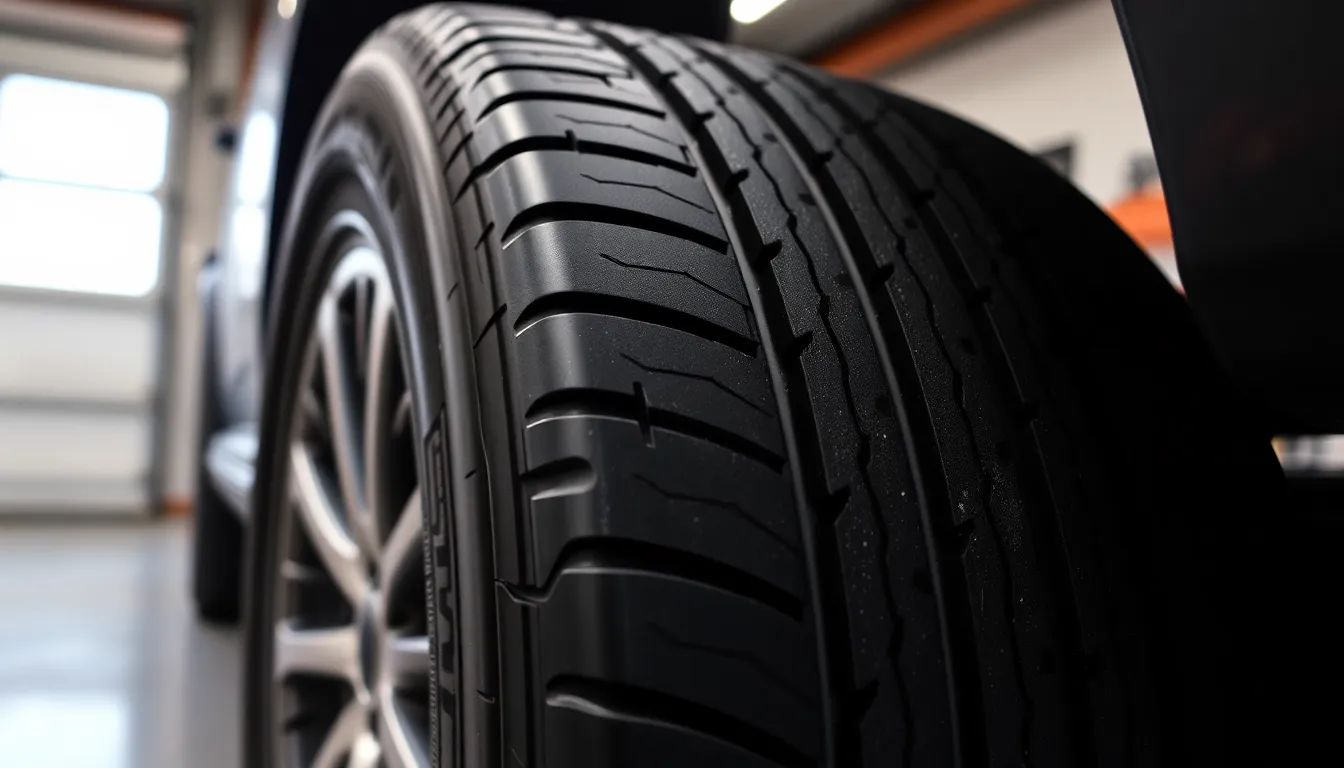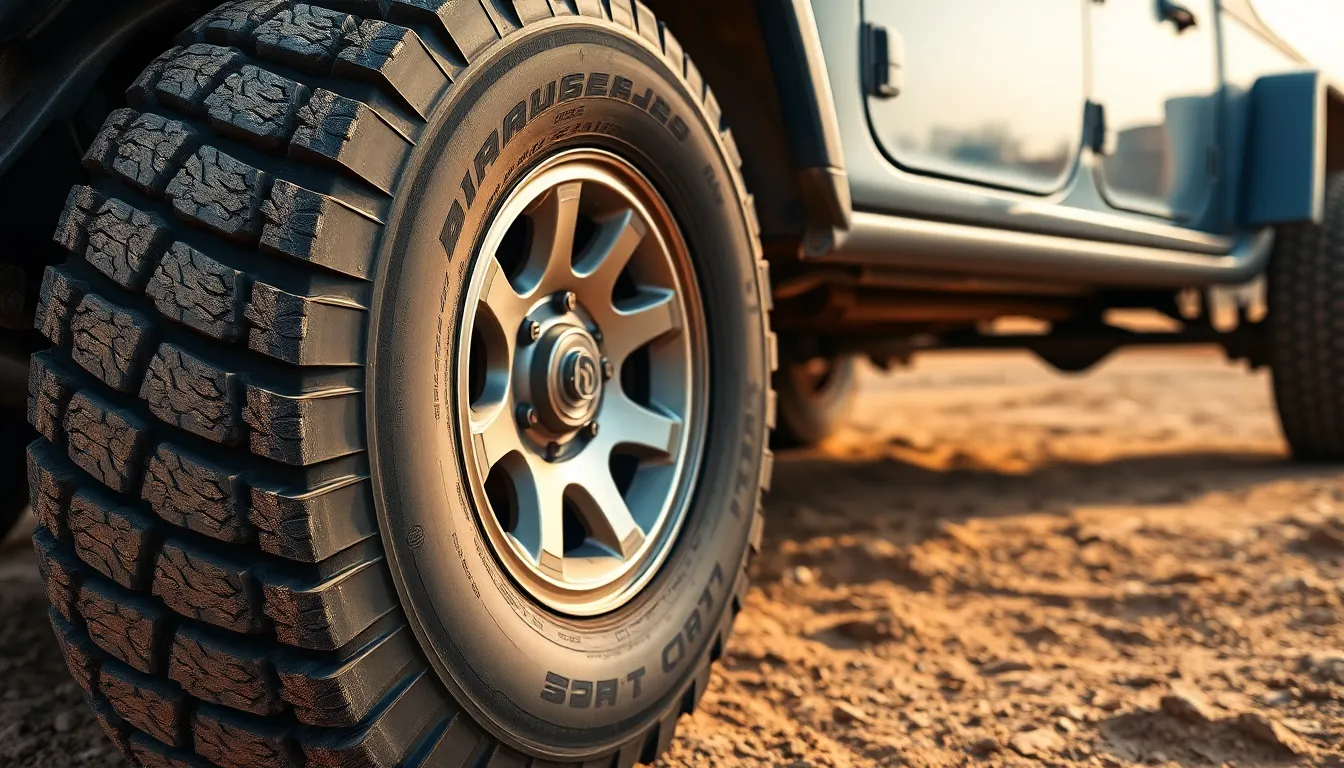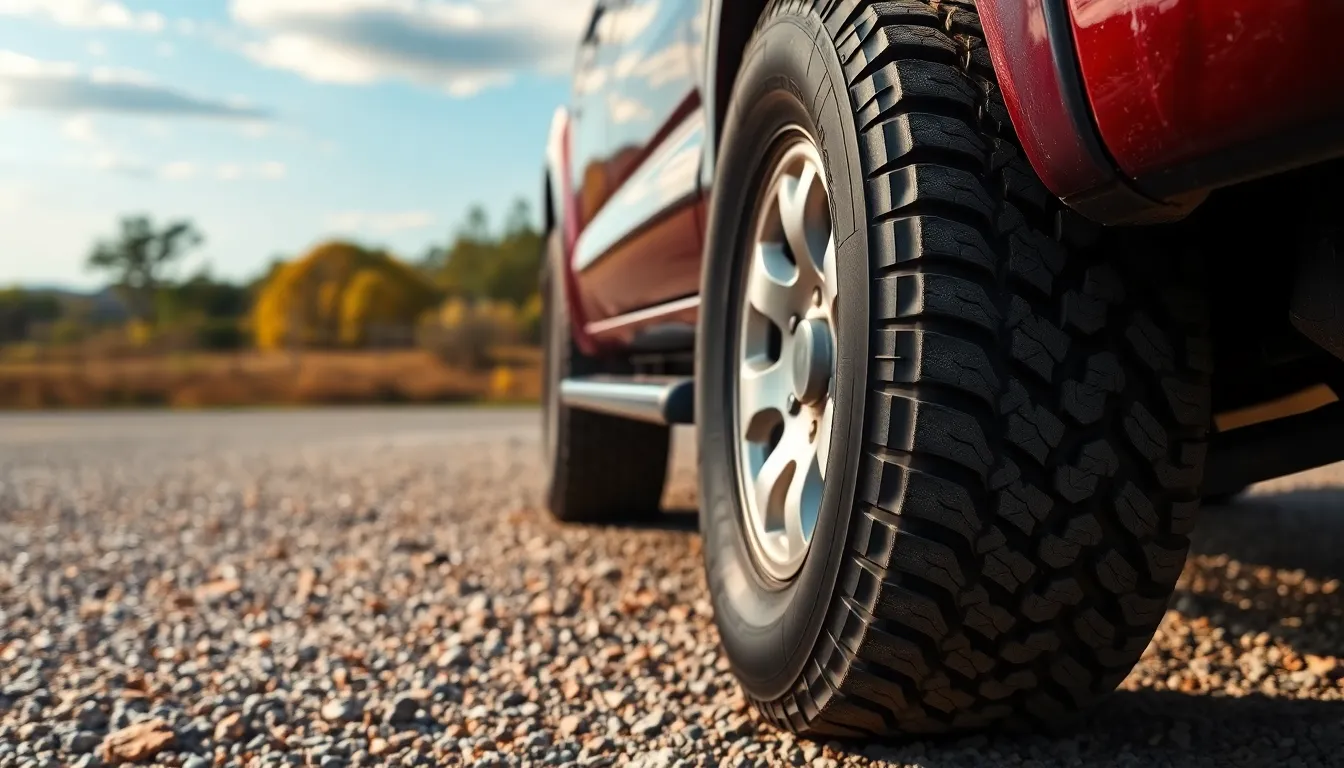When we’re shopping for tires or trying to understand our vehicle’s specifications, tire size numbers can feel like a confusing code. The designation “275 60 R20” appears on countless trucks and SUVs, but what do these numbers actually mean in practical terms?
We’ve all been there – staring at tire sidewalls wondering how to translate those cryptic measurements into real-industry dimensions. Understanding that a 275/60R20 tire measures approximately 33.0 inches in overall diameter can make all the difference when you’re planning modifications, checking clearances, or simply wanting to know more about your vehicle.
Converting tire sizes from metric to inches isn’t just about satisfying curiosity. We’ll break down exactly how this popular tire size translates to inches, why it matters for your driving experience, and what these measurements mean for your vehicle’s performance and appearance.
Understanding Tire Size 275/60R20
A 275/60R20 tire size follows the standardized tire sizing system used across the automotive industry. We break down each component to reveal the exact measurements and specifications that determine your tire’s performance characteristics.
Breaking Down the Numbers
The tire designation 275/60R20 contains three distinct numerical values that define exact tire dimensions. Each number represents a different measurement crucial for proper fitment and performance.
275 indicates the tire width measured in millimeters from sidewall to sidewall. This measurement represents the widest point of the tire when mounted on the recommended rim width.
60 represents the aspect ratio as a percentage of the tire width. This figure tells us the sidewall height equals 60% of the 275mm width measurement.
20 specifies the wheel diameter in inches that the tire fits. This measurement refers to the internal diameter of the tire where it contacts the rim.
What Each Component Means
Width measurement of 275mm translates to approximately 10.83 inches across the tire’s contact patch. Wider tires like this size provide increased stability and improved cornering performance compared to narrower alternatives.
Aspect ratio of 60 creates a sidewall height of 165mm or 6.5 inches. Lower aspect ratios produce shorter sidewalls that enhance steering response but may reduce ride comfort on rough surfaces.
Rim diameter of 20 inches indicates compatibility with 20-inch wheels exclusively. Larger wheel diameters typically improve braking performance and vehicle aesthetics while potentially affecting ride quality.
Construction type “R” stands for radial construction where tire plies run perpendicular to the direction of travel. Radial tires offer superior fuel economy, longer tread life, and better heat dissipation compared to bias-ply alternatives.
| Component | Measurement | Inches Equivalent |
|---|---|---|
| Width | 275mm | 10.83 inches |
| Sidewall Height | 165mm | 6.5 inches |
| Rim Diameter | 20 inches | 20 inches |
| Overall Diameter | 838mm | 33.0 inches |
Converting 275/60R20 to Inches

Converting 275/60R20 tire dimensions to inches reveals the practical measurements drivers experience on their vehicles. These conversions help us understand actual tire size for clearance calculations and performance considerations.
Overall Tire Diameter
The overall diameter of a 275/60R20 tire measures approximately 33.0 inches. We calculate this by adding the rim diameter (20 inches) to twice the sidewall height (6.5 inches each). This calculation follows the formula: rim diameter + (2 × sidewall height) = total diameter.
Our measurement translates to a tire that stands 33.0 inches tall when mounted and properly inflated. This diameter affects ground clearance, speedometer accuracy, and gear ratios in your vehicle.
Tire Width in Inches
The 275mm width converts to 10.83 inches across the tire’s tread surface. We obtain this measurement by dividing 275 millimeters by 25.4 (the conversion factor from millimeters to inches). This width represents the distance from one sidewall to the other at the tire’s widest point.
Our 10.83-inch width provides the contact patch that affects traction, stability, and handling characteristics. Wider tires like these offer improved cornering grip but may increase rolling resistance and road noise.
Sidewall Height Calculation
The sidewall height calculates to 6.5 inches using the 60% aspect ratio applied to the 275mm width. We multiply 275mm by 0.60 to get 165mm, then convert to inches by dividing by 25.4. This sidewall measurement represents the distance from the rim edge to the tread surface.
Our 6.5-inch sidewall height balances ride comfort with steering responsiveness. Taller sidewalls absorb more road imperfections but reduce precise steering feedback compared to lower profile alternatives.
Key Measurements of 275/60R20 Tires

Converting the 275/60R20 tire designation into inches reveals three critical measurements that directly impact vehicle performance and compatibility.
Diameter: 33 Inches
The overall diameter of 275/60R20 tires measures 33.0 inches from top to bottom. This measurement combines the 20-inch rim diameter with 13 inches of total sidewall height (6.5 inches on each side). Ground clearance increases by approximately 0.5 inches for every inch of additional tire diameter compared to stock sizes. Speedometer readings become less accurate when changing from smaller diameter tires, with a 33-inch tire causing the speedometer to read slower than actual speed. Larger diameter tires also affect gear ratios, potentially reducing acceleration but improving fuel economy at highway speeds.
Width: 10.8 Inches
The tire width of 275mm converts to 10.83 inches measured from sidewall to sidewall at the widest point. Contact patch area increases with wider tires, providing enhanced traction during cornering and braking. Wider tires distribute vehicle weight across more road surface, improving stability at higher speeds. But, increased width can cause hydroplaning at lower speeds in wet conditions due to the larger contact area. Fuel economy typically decreases with wider tires due to increased rolling resistance and aerodynamic drag.
Sidewall Height: 6.5 Inches
The sidewall height measures 6.5 inches from the rim edge to the tread surface. This dimension represents 60% of the tire’s 275mm width, creating a moderate profile that balances comfort and performance. Taller sidewalls absorb more road imperfections, providing a smoother ride quality over rough surfaces. Steering response becomes slightly delayed with taller sidewalls due to increased flex during cornering. Load carrying capacity improves with adequate sidewall height, as the tire can better distribute weight and maintain proper contact with the road surface.
Performance Characteristics

Performance characteristics of 275/60R20 tires directly affect driving dynamics across multiple vehicle systems. These dimensions create exact trade-offs between comfort, efficiency, and handling capabilities.
Ride Comfort and Handling
Ride comfort receives important enhancement from the 6.5-inch sidewall height found in 275/60R20 tires. The substantial sidewall absorbs road imperfections, bumps, and surface irregularities more effectively than lower-profile alternatives. Drivers experience reduced harshness from potholes and construction zones due to this increased cushioning effect.
Handling characteristics demonstrate a balanced approach with this tire specification. The 10.83-inch width provides substantial contact patch area, improving cornering stability and grip during turns. Steering response occurs with slight delay compared to lower-profile tires, as the taller sidewall flexes more during direction changes.
Braking performance benefits from the wider contact patch, distributing stopping forces across more rubber surface area. The increased tire footprint creates better traction during emergency stops on both dry and wet surfaces. Body roll decreases during cornering maneuvers due to the wider stance, though not as dramatically as with wider, lower-profile tire combinations.
Fuel Economy Impact
Fuel economy experiences measurable changes with 275/60R20 tire dimensions compared to smaller alternatives. The 33-inch overall diameter increases rolling resistance, requiring more engine power to maintain highway speeds. This larger diameter also affects final drive ratios, causing the engine to operate at lower RPMs during cruising conditions.
Weight considerations play a important role in fuel consumption patterns. These larger tires typically weigh 5-8 pounds more per tire than smaller alternatives, adding 20-32 pounds of unsprung weight to the vehicle. The additional rotational mass requires more energy during acceleration and deceleration cycles.
Aerodynamic drag increases with the wider 10.83-inch tire profile, creating more air resistance at highway speeds. Wind noise levels may also increase slightly due to the broader tire footprint interacting with airflow around the wheel wells. Rolling resistance coefficients typically measure 10-15% higher than narrower tire options, directly impacting fuel consumption during city and highway driving.
Popular Vehicles Using 275/60R20 Tires

Pickup trucks dominate the 275/60R20 tire size market with models like the Ford F-150, Chevrolet Silverado 1500, and RAM 1500 frequently equipped with these dimensions from the factory. Full-size SUVs including the Chevrolet Tahoe, Ford Expedition, and GMC Yukon also use this tire size to balance ride comfort with load-carrying capability.
The Nissan Titan and Toyota Tundra feature 275/60R20 tires on many trim levels to provide optimal ground clearance and towing performance. Luxury pickup trucks such as the Ford F-150 King Ranch and Chevrolet Silverado High Country rely on this tire size to deliver premium ride quality while maintaining rugged capability.
| Vehicle Category | Popular Models | Typical Use Case |
|---|---|---|
| Full-Size Pickups | Ford F-150, Chevrolet Silverado 1500, RAM 1500 | Daily driving and light towing |
| Heavy-Duty Pickups | Nissan Titan, Toyota Tundra | Work applications and heavy hauling |
| Full-Size SUVs | Chevrolet Tahoe, Ford Expedition, GMC Yukon | Family transportation and cargo hauling |
| Luxury Trucks | Ford F-150 King Ranch, Silverado High Country | Premium daily driving |
Commercial fleet operators choose 275/60R20 tires for their versatility across different driving conditions and load requirements. These tires accommodate both urban commuting and highway travel while providing adequate sidewall height for off-road excursions when needed.
Mid-size SUVs occasionally use 275/60R20 tires on higher trim levels where manufacturers prioritize comfort over fuel economy. The tire size offers excellent stability for vehicles weighing between 5,000 and 7,000 pounds while maintaining reasonable rolling resistance for daily use.
Comparing 275/60R20 to Other Common Sizes

Understanding how 275/60R20 tires compare to similar sizes helps us make informed decisions about tire upgrades or replacements. We’ll examine the key differences in dimensions and performance characteristics between closely related tire sizes.
Versus 275/55R20
275/55R20 tires feature the same 10.83-inch width as our 275/60R20 reference but reduce the sidewall height to 5.9 inches compared to 6.5 inches. This shorter sidewall creates an overall diameter of 31.9 inches instead of 33.0 inches, reducing ground clearance by approximately 0.55 inches.
Lower profile sidewalls in 275/55R20 tires deliver sharper steering response and improved cornering precision due to reduced sidewall flex. Braking performance increases with the stiffer sidewall construction, providing better feedback during aggressive driving maneuvers.
Ride comfort decreases with 275/55R20 tires as the shorter sidewall absorbs less road impact compared to the taller 275/60R20 profile. Road noise typically increases due to reduced cushioning between the rim and road surface.
| Specification | 275/60R20 | 275/55R20 | Difference |
|---|---|---|---|
| Overall Diameter | 33.0 inches | 31.9 inches | -1.1 inches |
| Sidewall Height | 6.5 inches | 5.9 inches | -0.6 inches |
| Ground Clearance | Higher | Lower | -0.55 inches |
| Steering Response | Moderate | Sharp | Improved |
Versus 285/60R20
285/60R20 tires maintain the same 60% aspect ratio as our reference tire but increase width from 275mm to 285mm, creating an 11.22-inch contact patch. Sidewall height remains identical at 6.5 inches, but the wider tire produces a 33.5-inch overall diameter compared to 33.0 inches.
Traction improves significantly with 285/60R20 tires due to the 0.39-inch wider contact patch, improving grip during acceleration and cornering. Snow and mud performance increases with the additional tread width, making these tires popular for off-road applications.
Fuel economy decreases with 285/60R20 tires as the wider profile creates more rolling resistance and aerodynamic drag. Weight increases by approximately 3-5 pounds per tire, affecting acceleration and braking distances.
Load carrying capacity improves with 285/60R20 tires, making them suitable for heavy-duty pickup trucks and commercial vehicles requiring maximum payload ratings. Steering effort increases slightly due to the larger contact patch creating more road friction.
| Specification | 275/60R20 | 285/60R20 | Difference |
|---|---|---|---|
| Width | 10.83 inches | 11.22 inches | +0.39 inches |
| Overall Diameter | 33.0 inches | 33.5 inches | +0.5 inches |
| Contact Patch | Standard | Wider | +0.39 inches |
| Load Capacity | Standard | Higher | Increased |
Shopping Tips for 275/60R20 Tires

Shopping for 275/60R20 tires requires comparing performance ratings across multiple manufacturers to find the best match for your driving needs. We recommend checking the Uniform Tire Quality Grading (UTQG) ratings that display treadwear numbers typically ranging from 400 to 700 for this size category.
Price comparison strategies help identify the best deals without compromising quality. Online retailers often offer 275/60R20 tires at 15-25% lower prices than brick-and-mortar stores. Warehouse clubs like Costco and Sam’s Club frequently provide competitive pricing with installation packages that include mounting balancing and valve stems.
Seasonal timing affects tire prices significantly throughout the year. October through December represents peak demand periods when prices increase by 10-15% above average. March and April offer optimal purchasing windows with manufacturer rebates of $50-100 per set becoming available.
Load index verification ensures your selected 275/60R20 tires support your vehicle’s weight requirements. Most tires in this size carry load indexes between 113-116 corresponding to weight capacities from 2535 to 2756 pounds per tire. Heavy duty pickups and loaded SUVs require load indexes of 115 or higher for safe operation.
Speed rating consideration matches tire capabilities to your driving patterns. H-rated tires (130 mph maximum) work well for highway commuting while T-rated options (118 mph maximum) suit urban driving scenarios. Performance oriented drivers benefit from V-rated tires supporting speeds up to 149 mph.
Warranty comparison reveals manufacturer confidence in tire longevity and performance. Premium brands typically offer 60000 to 80000 mile treadwear warranties on 275/60R20 all season tires. Road hazard protection adds $15-25 per tire but covers damage from nails potholes and debris.
Installation considerations include checking your vehicle’s tire pressure monitoring system compatibility. Newer 275/60R20 tires require TPMS sensor transfers that cost $20-40 per wheel at most service centers. Professional installation ensures proper torque specifications and prevents premature wear patterns.
Conclusion
Understanding that your 275/60R20 tire measures 33.0 inches in overall diameter empowers you to make informed decisions about your vehicle’s performance and modifications. We’ve covered how these dimensions directly impact everything from fuel economy to ride comfort and why this knowledge matters for your driving experience.
Whether you’re shopping for replacements or considering upgrades we hope this breakdown of tire sizing helps you navigate the often confusing industry of tire specifications. The 275/60R20 remains a popular choice for good reason – it strikes an excellent balance between comfort capability and versatility across many truck and SUV applications.
Armed with this information you’re now ready to make confident tire decisions that match your vehicle’s needs and your driving style.
Frequently Asked Questions
What does 275/60R20 mean in tire sizing?
The 275/60R20 designation breaks down as follows: 275mm tire width (10.83 inches), 60% aspect ratio (sidewall height is 60% of width), R indicates radial construction, and 20 refers to the rim diameter in inches. This creates an overall tire diameter of approximately 33.0 inches.
How big is a 275/60R20 tire in inches?
A 275/60R20 tire measures 10.83 inches wide, has a 6.5-inch sidewall height, and an overall diameter of 33.0 inches. The rim diameter is 20 inches. These dimensions make it suitable for trucks and SUVs requiring good ground clearance and load capacity.
What vehicles commonly use 275/60R20 tires?
Popular vehicles include pickup trucks like Ford F-150, Chevrolet Silverado 1500, and RAM 1500. Full-size SUVs such as Chevrolet Tahoe and Ford Expedition also use this size. Heavy-duty trucks like Nissan Titan and Toyota Tundra benefit from this tire’s optimal ground clearance and towing performance.
How do 275/60R20 tires affect fuel economy?
These tires negatively impact fuel economy due to their larger diameter increasing rolling resistance, added weight requiring more engine power, and wider profile creating more aerodynamic drag. The combination of these factors typically results in decreased miles per gallon compared to smaller tire sizes.
What’s the difference between 275/60R20 and 275/55R20 tires?
The 275/55R20 has a shorter sidewall (5.4 inches vs 6.5 inches), resulting in better steering response and cornering precision but reduced ride comfort. The overall diameter is smaller at 31.9 inches compared to 33.0 inches for the 275/60R20, affecting ground clearance and speedometer readings.
How do 275/60R20 tires perform in terms of handling and comfort?
The 6.5-inch sidewall provides excellent ride comfort by absorbing road imperfections, while the 10.83-inch width improves cornering stability and grip. However, steering response may be slightly delayed due to the taller sidewall. The wider contact patch enhances braking performance and traction.
What should I consider when shopping for 275/60R20 tires?
Compare performance ratings and UTQG ratings, verify load index and speed rating compatibility with your vehicle, and compare warranties. Online retailers often offer better prices than physical stores. Consider seasonal timing for better deals and ensure professional installation for optimal performance and TPMS compatibility.
Can I replace my current tires with 275/60R20 if they’re a different size?
Tire size changes can affect speedometer accuracy, ground clearance, and vehicle performance. Consult your owner’s manual or tire professional to ensure the 275/60R20 size is approved for your vehicle. Consider impacts on gear ratios, clearances, and overall driving dynamics before making the switch.














